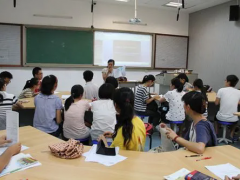英语代词总结
1.英语代词总结
用法:1人称代词主格作主语。当几个不同的人称代词时,排列顺序是:单数是二、三、一。复数是一、二、三。
2人称代词宾格作宾语。主要用在动词和介词后。
3形容词性物主代词相当于一个形容词,后必需加名词。
4名词性物主代词相当于一个名词,后不用加名词。(形容词性物主代词+名词=名词性物主代词。
5反身代词主要用一些固定词组中:teach oneself; learn by oneself; enjoy oneself; help oneself(to +sth.);hurt oneself; by oneself; see ……oneself; say oneself;dress oneself
2.英语代词总结
用法:1人称代词主格作主语。
当几个不同的人称代词时,排列顺序是:单数是二、三、一。复数是一、二、三。
2人称代词宾格作宾语。主要用在动词和介词后。
3形容词性物主代词相当于一个形容词,后必需加名词。4名词性物主代词相当于一个名词,后不用加名词。
(形容词性物主代词+名词=名词性物主代词。5反身代词主要用一些固定词组中:teach oneself; learn by oneself; enjoy oneself; help oneself(to +sth.);hurt oneself; by oneself; see ……oneself; say oneself;dress oneself单数复数用法thisthese指下文将要提及的事近指This is my book. thatthose指前面(上文)刚刚提过的事⑴远指That is her bike.it one that 的区别:it用来指特指,指上下文提到同一对象,同一事物。
eg: May I use your bike? Sure ,you can use it.(=the bike.)one 泛指,指上文提到的同类事物中一个,同类而不同一。Who has a pen? I have one .(a pen)that 代替前面提到的名词,以避免重复。
The weather in Beijing is colder than that(the weather)in Guangzhou.somebody(某人)anybody(任何人)nobody(没有人)everybody (每人)someone(某人)anyone(任何人)no one(没有人)everyone(每人)something(某事)anything(任何事)nothing(没有东西)everything(一切、万物)1. some, any ,no,和every可以和one, body, thing构成复合代词,它们的用法与some any的用法相同some用在肯定句和期待得到对方的肯定的回答的疑问中。 any用于疑问句、否定句和条件中。
2 修饰不定代词的词一定要放在不定代词后。I have something important to tell you.3. 当主句的主语是人的复合不定代词如 eveybody ,nobody ,anyone等时,其反意疑问句的主语通常用代词they;当主句中的主语是指物复合不定代词如everything, anyting, something nothing等时,其反意疑问句的主语用代词it. Everyting is ready, isn't it? Everyone is here, aren't they?4.复合不定代词本身做主语时谓语用单数。
5.everybody=everyone,只能指人; every one既可指人又可指物,还可以和 of连用。what询问某人的职业What does his father do?(what's his father?) He is a workerwho询问某人的身份、姓名Who is the boy? He is Li Ming.what指不定数目中的“哪一个,哪一些”。
没有一定范围的限定。What would you like?which“哪一个,”在一定范围内特指的人或物。
Which do you like,spring or summer?There are many trees on the both sides./on the each side .on the either side road.都任何每一个都不两者botheithereveryneither三者(以上)allanyeachnone1. both两者都;all三者或三者以上人或物都。在句中作主语时,谓语用复数。
与not连用时,表示部分否定,译为“并非所有都……Both John and Ann have friends.All of us don't like meat.=Not all of us like meat.2.either用于两者,指两者之一(两者间任何一个); any用于三者或三者以上。When shall we meet,this evening or tomorrow morning. Either time is OK. when shall we meet? Any time is OK.3.neither是 both的反义词,表示“两者都不”。
作主语时谓语用单数。none是all的反义词,表示“三者或三者以上的人或物都不。”
作主语时可单可复。注意none与no one的区别。
可数不可数肯定a few(有一些)a little(有一点)否定few(几乎没有)little(几乎没有)There is a little water in the bottle, is there?There is little water in the bottle, isn't there?不定代词意义用法说明other另外的只作定语,常与复数名词或不可数名词连用;前面有the.this,that,some,your等时,则可以与单数连用。Other+名词=othersthe other两者中的另一个常与one连用,构one……the other;the other+名词=the othersothers泛指别的人或物是的other复数形式;泛指别的人或物(但不是剩余的全部),不能作定语,构成some……others……the others特指其余的人或物是the other的复数形式,特指剩余的全部的人或物another任何一个,另一个指三者或三者以上中的任何一个,用作形容词或代词another+单数名词;another+数词+复数名词 译为“再 又”1.I have two pens. One is red, the other is blue2.I don't like the book, please give me another one..3.Some students are listening to the radio, others (=other students) are watching TV.(可能还有一些人在干别的。)
4.There are thirty students in our class. Twenty are girls, the other students(=the others) are boys.5. There are thirty students in our class. Twenty are from Beijing. The others are from Nanjing.(其余的全来自南京)6. There are thirty students in our class. Twenty are from Beijing. others are from Nanjing.(还有来自南京的,暗示其余十人不只是来自南京,还可能有来自上海等地。)7.You can stay another ten days.=You can stay ten more days.。
3.代词的分类及基本用法
(一)代词的类别 相互代词 each other,one another 指示代词 this,that,these,those 不定代词(不指明特定的人或事物的代词)each,every,both,all,either,neither,none,no,one,(a)few,(a)little,some,any,many,much,other,another 复合不定代词 everybody,somebody,anybody,nobody,everyone,someone,anyone,no one,every-thing,something,anything,nothing 疑问代词 what,who,whom,which,whose 直接代词 疑问代词都可作连接代词,引导宾语从句.表语从句等. 关系代词 who,whom,whose,that,which用引导定语从句. (二)代词的用法 1.人称代词、物主代词、反身代词、相互代词和指示代词的用法 (1)人称代词有主格和宾格之分,主格用来作主语,宾格用来作动词或介词的宾语等. eg. She gave me a red apple.她给了我一个红苹果: (She作主语,me作动词宾语) Kath is near him.凯西靠近他.(介词near的宾语) 2.物主代词有形容词性物主代词和名词性物主代词之分. ①形容词性物主代词位于名词前:their school,his backpack ②名词性物主代词相当干一个名词,在句中可作主语、宾语等,后面不能再接名词. egIt isn't my pen.→Mine(=my pen) is missing.(作主语) I left my pen at home. You can use hers(=her pen),(作宾语) ③“of+名词性物主代词”属双重所有格的一种形式. eg.a cat of hers她的一条狗,a friend of yours你的一个朋友 3.反身代词 ①反身代词在句中可作同位语,起强调作用,也可作动词或介词的宾语. eg.A few days later,I myself had to go to Paris.(作同位语) She bought herself a new bag.(作动词宾语) He's not worried about himself.(作介词宾语) ②带有反身代词的常用短语. teach oneself 自学 help oneself to 随便吃些…吧 say to oneself 自言自语. learn……by oneself 自学… enjoy oneself 过得愉快 leave one by oneself 把某人单独留下 hurt oneself 伤了自己 dress oneself 自己穿衣服 come to oneself 苏醒过来 4.相互代词 ①表示相互关系,可用作动词或介词的宾语,用法区别不大. eg. For years, the two sisters looked after one another(each other).多年来姐妹俩互相照顾. We should learn from each other. 我们应当互相学习. ②可以用格表示所有关系:each other's, one another's互相的,彼此的 eg.They are looking at each other's pictures.他们相互看对方的照片.5.指示代词 ①指示代词有单复数之分,既可指物,也可用于介绍人. eg. This is an apple tree,and that is an orange tree.这是一棵苹果树,那是一棵桔子树. These are my friends,and that is my sister.这些是我朋友,那个是我姐姐. ②指示代词可用来指上文中提到的事情: eg.Steve had a bad cold.This/That was why he didn't come to school yesterday. 2.不定代词 (1)each,every,both,all,either,neither,no,none的用法 ①each“每个/各个”(强调个体),用于两者或两者以上. eg.Two girls came and l gave an apple to each.来了俩姑娘,我给她们每人一个苹果. Each of them has a nice ring.她们每人有一枚漂亮的戒指. ②every“每个/各个”(强调全体),用于两者以上.every常作形容词用. eg.Every day is important to us.每天对我们都很重要. He has read every book(all the books) On the subject.他阅读了所有有关这个主题的书. ③both表示两者“都”(强调全体). eg.Her parents are both doctors.她父母都是医生. Both of them are doctors.他俩都是医生. They both like potatoes.他俩喜欢吃土豆. ④all“全体/大家/一切”用于三者以上,也可接不可数名词. eg.That's all for today.今天到此为止. All of us are from China.我们都来自中国. All the food is delicious.所有的食物都很好吃. ⑤either“两者之一”,用于两者(强调个体). eg.The two coats are cheap,so you can choose either of them.那两件外套不贵,你可以随便挑一件. ⑥neither“两个都不”,用于否定两者. eg. Neither Of the books is/are so interesting.那两本书没一本好看的. ⑦no(=not any/not a)“没有”可接可数名词单复数,也可接不可数名词. eg.I have no brothers Or sisters.我没有兄弟姐妹. A clock has no mouth,but it can talk. 钟表没有嘴,但能说话. There is no fire without some smoke.有火就有烟. ⑧none“没有一个人/物”用于否定三者或三者以上的可数名词 eg.None Of them has/have been to Japan.他们都没去过日本. I like none of the books.这些书我全都不喜欢. ⑨neither和none表示完全否定;all,both,each和every(含every的复合词)等与not连用时表示部分否定. eg.I don't know all of you.我不完全认识你们. Not everyone Of us know how to go there.不是我们每个人都知道怎样去那儿(2)one,ones和no one的用法 one用来代替前面刚提到的一个东西或一个人,以免重复;复数ones用来代替前面提到的一些物或一些人;no one表示否定. eg.——Would you please pass me the science book?给我递过那本科学方面的书好吗? 一Which one?哪一本? 一The one on my shelf.我书架上的那本. No one has traveled farther than to the moon.没有人旅行远过月球. (3)(a)few,(a)little;many,。
4.
星期一:Monday星期二:Tuesday星期三:WenSday星期四:Thursday星期五:Friday星期六:Saturday星期天:Sunday1-100 one two three four five six seven eight nine ten eleven twelve thirteen fourteen fifteen sixteen seventeen eighteen nineteen twenty thirty forty fifty sixty seventy eighty ninety one/a hundred one thousand.人称代词(Peronsal Pronouns)是指可以代替人.物.地点的名词.疑问代词是用来提出问题的词.who ,what ,which ,whose 等是疑问代词.指示代词是用来表示指示的词.this ,that ,these ,those 是指示代词.当所指物品在附近时,用this,these ,当所指物品较远时,用that或those ten thousand。
5.总结一下英语中的名词和代词
名词 定义 名词是表示人,事物,地点或抽象概念的名称。
例如: desk 桌子 time 时间 life 生活 book 书本 room 房间 honest 诚实 worker 工人 pencil 铅笔 computer 计算机 city城市 homework家庭作业 [编辑本段]用法: 在句子中用作动词的主语或宾语的词,或是在独立结构中表示名称的词,或是在联系动词后作表语用的词 [编辑本段]分类 名词分为专有名词和普通名词 专有名词: 表示具体的人,事物,地点或机构的专有名称。例如: China 中国 Asia 亚洲 Beijing 北京 普通名词: 表示某些人,某类事物,某种物质或抽象概念的名称。
例如: teacher 老师 tea 茶 reform 改革 普通名词又可进一步分为四类 1) 个体名词(Individual Nouns):表示单个的人和事物。 horse 马 car 汽车 room 房间 apple 苹果 fan 风扇 picture 照片 2) 集体名词(Collective Nouns): 表示一群人或一些事物的名称。
people 人们 family 家庭 army 军队 government政府 group 集团 3) 物质名词(Material Nouns):表示物质或不具备确定形状和大小的个体的物质。 fire 火 steel 钢 air 空气 water 水 milk 牛奶 4)抽象名词(Abstract Nouns):表示动作,状态,品质或其他抽象概念。
labour 劳动 health 健康 life 生活 friendship友情 patience耐力 名词又可分为可数名词(Countable Nouns)和不可数名词(Uncountable Nouns)。 _______________________________________ | |专有名词 | | | 名 | | 个体名词 | | | | | | 可数名词 | | | | 集体名词 | | | |普通名词 | | | | 词 | | 物质名词 | | | | | | 不可数名词| | | | 抽象名词 | | 可数名词有单,复数之分,表示一个或多个。
a book 一本书 two books 两本书 不可数名词:不分单,复数;抽象名词, 物质名词和专有名词一般是不可数名词。 sand 沙 sugar 糖 有少数名词即可作可数名词,也可作不可数名词,但含义不同。
glass 玻璃 glasses 玻璃杯 paper 纸 paper 报纸,文件 [编辑本段]名词的功能 名词在句中作主语, 宾语,介词宾语,宾语补助语,表语以及名词短语作状语。 The bag is in the desk. bag 作主语。
书包在桌子里边。 I washed my clothes yesterday. clothes 作宾语。
昨天我洗了我的衣服。 This is a good book. book 作表语。
这是一本好书。 We selected him our monitor. monitor作宾语补助语。
我们选他为我们的班长。 Mary lives with her parents. parents作介词宾语. 玛丽和她的父母亲住在一起。
He is a Party member. Party 作定语. 他是一名党员。 They study hard all the day. 他们白天黑夜地学习。
[编辑本段]名词的数 1)一般加S 2)以S,x,sh,ch结尾的词加ES 3以元音字母+Y结尾的词直接+S bookshelves, wives, knives 4) 名词以辅音+y 结尾的,变 y 为 i ,再加 es。 cities,babies, factories. 5) 名词以+ o 结尾的,有生命的,如potato,则加-es;无生命的,如photo,则直接加s。
极少数名词虽然以-o 或者-f 结尾, 变成复数则只加 -s,为数不多, 如 radios pianos photos roofs 等。 英语中有些名词的复数形式是不规则的,需要一一记忆常见的有, man - men woman - women foot - feet tooth - teeth mouse - mice ox - oxen sheep - sheep deer - deer fish - fish [编辑本段]名词的格 在英语中,名词的格有三个,主格,宾格和所有格。
它们的形式及其变化表示与其他词的关系。实际上, 主格和宾格通过它在句中的作用和位置来确定。
The bird is in the tree. 鸟在树上。 bird 作主语, 是主格。
I saw a film yesterday. 昨天我看了一场电影。 film 作宾语,是宾格。
名词的所有格: 名词中表示所有关系的形式叫做名词所有格。 Lu Xun's book is worth reading. 鲁迅的书值得一读。
This is my father's room. 这是我父亲的房间。 以-s 或 -es 结尾的复数名词的所有格只在名词后加 “ ' ”。
There are many students' exercise books here. 这儿有许多学生的练习本。 复合名词的所有格 " 's " 加在后面的名词之后. This is my son-in-law's bike. 这是我女婿的自行车。
如果一样东西为两人共有,则只在后一个名词后加 " 's "。 We visited Xiao Li and Xiao Zhang's room. 我们参观了小李和小张的房间。
名词的复数一般结尾有“s”所以变所有格时只加“'”但特殊的名词复数仍要加 's如children就是child的名词复数形式它变所有格时则必须加 's 名词所有格所修饰的词,有时可以省略。如前文已经提到,或者指地点。
The book is not mine, but Li Hua's. 这本书不是我的,是李华的。 I had my hair cut in the barber's. 我在理发店理发了。
名词的双重所有格 物主代词不可与 a, an, this, that, these, those, some, any, several, no, each, every, such, another, which等词一起前置,修饰一个名词,而必须用双重所有格。 公式为: a, an, this, that +名词+of +名词性物主代词。
如: a friend of mine. each brother of his. 1.双重所有格是由非生物的所有格(即of+名词)与生物的所有格(如mother's, Tom's等)共同构成的。 2.双重所有格的形式可为名词+of+名词的所有格,其中of后面的生物的所有格之后的名词被省略;也可为名词+of+所有代名词。
Tom, Mike, and Mary were classmates of Stephen's. 汤姆,迈克和玛丽是史迪文的同学。 在生物的所。
6.初中英语各种词性的总结
一、冠词(3个)1. a 一个(件 / 只。
) 2. an 一个(件 / 只。
) 3. the 这;这个;那;那个 二.连词(24个)1. after 在。
以后 2. and 和;又 3. as 像。
一样;如同;因为 4. because 因为5. before 在。
之前 6. but 但是 7. if 如果;假使;是否;是不是 8. neither 也不9. nor 也不 10. or 或者;还是;否则 11. since 从。
以来;。
以后12. that 既然;由于;(引导宾语从句等) 13. though 虽然 14. till 直到;直到。
为止15. until 直到;直到。
为止 16. when 当。
的时候 17. whether 是否18. while 在/当。
的时候;和。
同时 19. than 比 20. so 因此;所以21. both。
and。 两个都;既。
又。
22. not only。
but also。 不但。
而且。
23. either。
or。 或者。
或者。
;不是。
就是。
24. neither。
nor。 既不。
也不。
三.介词(37个)1. about a. 在各处;四处 b. 关于 2. after a. 在。
之后 b. 在。
后面3. along 沿着 ; 顺着 4. as 作为 ; 当作 5. among a. 在。
中间 b. 在(三者或三者以上)之间6. at a. (表示地点/位置)在 b. (表示时间)在。
时(刻) c. (表示动作的目标和方向)7. before a. 在。
前面 b. 在。
以前 8. behind 在。
后面 9. below 在。
下面10. beside 在。
旁边 ; 靠近 11. between 在 (两者) 之间 ; 在。
中间12. by a. 在。
旁边;靠近 b. 在。
时间 c. (指时间)不迟于 d. (用于被动语态) 被 e. (表示方法、手段) 用 ; 由 f. (指交通工具等) 乘 ; 用13. down 沿着( 街道、河流)而下 14. during 在。
的期间 ; 在。
过程中 15. except 除。
之外16. for a. (表示方向) 往;向 b. (表示所属) 。
的 c. (表示时间距离) 计;达 d. (说明目的或用途) 为。
17. from a. (表示起点) 从 ; 自 b. (表示开始的时候) 从。
起 c. (表示距离) 距 ; 离 d. (表示来源) 来自18. in front of 在。
前面 19. into a. (表示动作的方向)到。
内;向内 b. (表示情况和结果的变化)变成20. in a. (表示位置)在。..里/内/中 b. 在。
(时间) c. 穿 ; 戴 d. 在。(情况 / 状况) 中 e. 使用(语言)21. like 像 22. near 在。
附近 ; 靠近 24. off (表示脱离)离开23. of a. (表示所属关系)。
的 b. (表示数量)。的 c. (表示其中)。
的25. on a. 在。
上面 b. 在。
时刻 c. 关于26. over a. 在。
上方(以上) b. 越过 c. 遍及27. past a. (指时间)过 b. 走过某处 28. since 自从。以来29. through a. 穿过 ; 通过 b. 从开始到结束30. till 直到。
为止 31. until 直到。
为止 32. up 在 / 向。
上面33. to a. (表示方向) 到 ; 向 b. (表示间接关系) 给 c. (表示钟点) 在。
之前34. with a. (表示具有) 带有 ; 具有 b. (表示手段或方法)用 ; 以 c. (表示伴随) 与。
一道 ; 和。一起35. without 没有 36. round 环绕一周 ; 围着 37. under 在 / 向。
下面 四、代词 人称代词 我 I / me 你 you / you 他 he / him 她 she / her 它 it / it 我们 we / us 你们 you / you 他/她/它们 they / them 物主代词 我的 my / mine 你的 your / yours 他的 his / his 她的 her / hers 它的 its / its 我们的 our / ours 你们的 your / yours 他/她/它们的 their / theirs 反身代词 我自己 myself 你自己 yourself 他自己 himself 她自己 herself 它自己 itself 我们自己 ourselves 你们自己 yourselves 他/她/它们自己themselves 复合不定代词 something 某事;某物 anything 什么事(物);任何事(物) nothing 没有东西 everything 每件事;事事 somebody (someone ) 某人;有人 anybody ( anyone ) 任何人 nobody ( no one ) 没有人 everybody ( everyone ) 每人;人人 this 这;这个 that 那;那个 these 这些 those 那些 who 谁 whom 谁 whose 谁的 what 什么 which 哪个;哪些 each other 互相;彼此 one another 互相;彼此 some 一些;若干 any (无论)哪个;(无论)哪些 many 许多人(或物) much 许多;大量 both 两者;两人;双方 neither 两者都不 either 两者之一 all 全部 ; 全体人员 none 没有任何人或东西 few 少数 ;不多 little 少量,少许 other 别人;别的东西 another另一个 each 每人;每个;每件 one 指代人/物/事 .副词(94个)1. about 大约;到处 2. above 在上面 3. after 在后;后来4. again 再一次;再;又 5. ago 以前 6. all 全部地7. almost 几乎;将近 8. along 向前;和。
一起 9. already 已经10. also 也 11. always 总是;永远 12. around 在周围;在附近13. away 离开;远离 14. back 向后;回原处 15. before 以前16. behind 在后面;向后 17. certainly 当然 18. close 近;靠近19. deep 深地 20. down 向下 21. early 早地22. either 也(不) 23. enough 足够地;充分地 24. even 甚至 ;更25. ever 曾经;无论何时 26. everywhere 到处 27. far 远地28. fast 快地;迅速地 29. first 最初 30. hard 努力地;(下雨 / 下雪等)猛烈地31. hardly 几乎不 32. here 这里;e5a48de588b6e799bee5baa6e79fa5e9819331333365643033在这里;向这里 33. home 回家;到家34. how 怎样;多少 35. in 在家;在内;向内 36. instead 代替;顶替37. just 正好 ;刚才;仅 38. last 最后地;最近刚过去39. late 迟地;晚地40. later 之后;过后 41. left 向左 42. little 很少地43. long 长久 44. loud 大声地;响亮地 45. low 低;矮46. much 非常;更。
7.不定代词用法总结
一、one,some,any的用法 1. one可泛指任何人或物,它还可以用在this,that的后面用来代替前面出现过的可数名词。
其复数形式为ones;所有格形式是one's;反身代词是oneself。如: One should love one's country. These apples are too small. Give me some bigger ones.(ones替代前面的apples) 2. some和any通常用作定语,修饰可数名词或不可数名词。
some修饰单数名词时,通常表示不确定的含义,意为“某个”。如: Some boy is waiting for you now. 3. some用于疑问句中,表示邀请或请求,或希望对方给予肯定的答复。
如: Would you like some tea? (表示邀请) Can I have some water? (希望得到肯定答复) 二、each和every的用法 1.each强调个别,可在句中充当主语、宾语、定语和同位语。every则强调整体。
2.each可表示两个或两个以上中的“每一个”,而every则要表示三者或三者以上中的“每一个”。如: There are trees and flowers at each side of the road. Every student in our class works hard. 三、no one与none的用法 no one 意为“没有人”,只能指人,不可指物。
常用于回答who引导的问句。它不可与介词of连用。
如: —Who is in the classroom? —No one. none既可指人,也可指物。它强调数量,意为“一点也不,一个也不”。
常用于回答how much和how many引导的问句。none还可与介词of连用。
与of连用时,通常指“三者以上的人或事物中没有一个”。如: —How much water is there in the bottle? —None. They were all tired, but none of them would stop to have a rest. 四、other和another的用法 1.other表示泛指,意为“另外的、别的、其它的”。
常与复数名词或不可数名词连用。如果其前有the,this,some,any,each,every,no,one以及形容词性物主代词时,其后就可接单数名词。
注意下面other的几种变形: others:它是other的复数形式,表示泛指,意为“别的人或物”,但不指全部。如: Many students are playing on the playground. Some are playing football;others are playing basketball. the other:表示两者中的另外一个。
可单独使用,也可后接单数名词。如: The old man has two sons. One is a worker,the other is a teacher. 但如果the other后接复数名词或者the other本身用复数形式 (the others),都可表示其余的全部。
如: We shall do some cleaning this afternoon. Group One will clean the wall. Group Two will clean the windows. The other students will sweep the floor. 2. another常用于指三者或三者以上中的“另外一个”。它可单独使用,也可后接名词。
如果其后接复数名词,则表示“又、再、还”。如: This cap is too small for me. Show me another (one). We need another three assistants in our shop. 五、all和both的用法 这两个词都可表示“都”,但all表示三者或三者以上的人或物,both则表示两个人或物。
它们都表示肯定意义,但如果它们与not连用时,则表示部分否定。如: All of them are middle school students. His parents are both teachers. Both of his parents aren't workers. All of the students aren't here on time. 六、neither和either的用法 这两个词都可用于表示两个人或物。
neither表示否定意义?意为“(两者中的每一个)都不”;而either则表示肯定意义,意为“(两者中的每一个)都”。它们用作代词时,可单独使用,也可同介词of连用。
用作形容词时,则可用于修饰后面的单数名词。如: Neither of them can speak Chinese. Either of them can speak Chinese. There are trees on either side of the street. There are trees on neither side of the street. 七、few和little的用法 few用作不定代词时,可用于替代可数名词,表示否定意义。
表示肯定意义时,则要用a few。 此外,few还可用作形容词,用于修饰可数名词。
如: Few students in this school can speak Japanese. There are still a few students in the classroom. little用作不定代词时,用于代替不可数名词,表示否定意义。表示肯定意义时,要用a little。
用作形容词时,则要修饰不可数名词。如: He is now out of work and can earn little money. I can speak a little French. 从以上讲解我们可以看出,在使用不定代词时,一要注意它们的词性(因为它们还可用作形容词);二要注意它们所表示的数量;三要注意它们是表示肯定还是否定。
只有这样,才能用好不定代词。
8.初中英语系动词总结
系动词及其用法总结
系动词亦称联系动词(link Verb),作为系动词,它本身有词义,但不能单独用作谓语,后边必须跟表语(亦称补语),构成系表结构说明主语的状况、性质、特征等情况。
说明:
有些系动词又是实义动词,该动词表达实义时,有词义,可单独作谓语,例如:
He fell ill yesterday.
他昨天病了。(fell是系动词,后跟补足语,说明主语情况。)
He fell off the ladder.
他从梯子上摔下来。fell是实义动词,单独作谓语。
1)状态系动词
用来表示主语状态,只有be一词,例如:
He is a teacher. 他是一名教师。(is与补足语一起说明主语的身份。)
2)持续系动词
用来表示主语继续或保持一种状况或态度,主要有keep, rest, remain, stay, lie, stand, 例如:
He always kept silent at meeting. 他开会时总保持沉默。
This matter rests a mystery. 此事仍是一个谜。
3)表像系动词
用来表示"看起来像"这一概念,主要有seem, appear, look, 例如:
He looks tired. 他看起来很累。
He seems (to be) very sad. 他看起来很伤心。
4)感官系动词
感官系动词主要有feel, smell, sound, taste, 例如:
This kind of cloth feels very soft.
这种布手感很软。
This flower smells very sweet.
这朵花闻起来很香。
5)变化系动词
这些系动词表示主语变成什么样,变化系动词主要有become, grow, turn, fall, get, go, come, run.
例如:
He became mad after that. 自那之后,他疯了。
She grew rich within a short time. 她没多长时间就富了。
6)终止系动词
表示主语已终止动作,主要有prove, trun out, 表达"证实","变成"之意,例如:
The rumor proved false. 这谣言证实有假。
The search proved difficult. 搜查证实很难。
His plan turned out a success. 他的计划终于成功了。(turn out表终止性结果)







